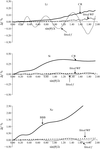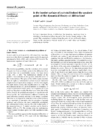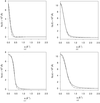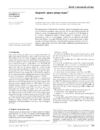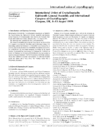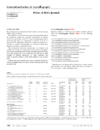issue contents
November 2001 issue

Cover illustration: Graphical representation of density modification due to third-order terms b113 = -b223 (point group ![]() ) in the Gram-Charlier series expansion of a Gaussian atomic probability density function. Courtesy of W. F. Kuhs.
) in the Gram-Charlier series expansion of a Gaussian atomic probability density function. Courtesy of W. F. Kuhs.
research papers
X-ray absorption by the monochromator determines the wavelength dispersion in the monochromated X-ray beam and explains the Δλ λ values of 0.03, 0.14 and 0.16 for graphite(002)-monochromated Cu, Mo and Rh radiation. To eliminate the systematic intensity truncation errors, caused by the large wavelength dispersion, a correction is proposed based on the applied scan angle and the real beam spectrum.
λ values of 0.03, 0.14 and 0.16 for graphite(002)-monochromated Cu, Mo and Rh radiation. To eliminate the systematic intensity truncation errors, caused by the large wavelength dispersion, a correction is proposed based on the applied scan angle and the real beam spectrum.
It is shown that additional Bragg reflections can appear in resonant near-edge X-ray diffraction exclusively owing to the local chirality associated with the left–right asymmetric environment of scattering atoms. This effect occurs even in centrosymmetric crystals, which are not gyrotropic in optics, and some realistic examples are considered in detail (α-Fe2O3, LiNbO3 etc.).
The coincidence site lattice theory is extended to multicrystalline ensembles, such as quadruple points and multiple junctions of grains.
Relativistic wave functions for elements with Z = 37–54 have been fitted with a linear combination of Slater-type functions for use in charge-density analysis. Numerical relativistic wave functions have been calculated for all chemically relevant ions up to Z = 54, and corresponding analytical espressions have been derived. The calculated X-ray scattering factors are parameterized with six Gausian functions. Results are available at http://harker.chem.buffalo.edu.
100 keV synchrotron radiation was used to obtain essentially absorption- and extinction-free data for the refinement of a multipole model electron-density distribution and ensuing topological analysis. Results are compared with ab initio density functional theory calculations and correlated with Si—O bond properties from geometry-optimized hydroxyacid molecules.
This paper describes a real-space reconstruction method for calculating electron-density maps.
A fast Newton method is developed to solve the entropy maximization problem in the Bayesian statistical approach to phase estimation. The method requires only O(n log n) instead of standard O(n3) floating point operations per iteration, while converging in the same rate as the standard Newton method.
In Laue's dynamical theory of diffraction, the boundary conditions claim to introduce a mathematical plane instead of the discrete atomic surface of the crystal. This assumption is analyzed from the point of view of Ewald's theory based on the microscopic discrete model of a crystal, where no boundary conditions are needed.
A description of a new phasing method and demonstration of its use for crystal and quasicrystal structure determination are presented.
The joint probability distribution functions method is applied to estimate phases from multiple-wavelength anomalous dispersion (MAD) data in the two-wavelength case for acentric crystals.
Extension of Bragg angle up to  has been examined theoretically for high-angle double-crystal X-ray diffractometry (HADOX). It is shown that an accuracy of a change in the lattice spacing to one part in
has been examined theoretically for high-angle double-crystal X-ray diffractometry (HADOX). It is shown that an accuracy of a change in the lattice spacing to one part in  can be attained.
can be attained.
Atomic scattering factors for  -shell electron energy-loss spectroscopy have been calculated for elements in the range
-shell electron energy-loss spectroscopy have been calculated for elements in the range  = 6 (carbon) to
= 6 (carbon) to  = 50 (tin).
= 50 (tin).
short communications
Opechowski–Guccione symbols for the 1651 magnetic space-group types are uniquely specified independent of International Tables for Crystallography.
Magnetic symmetry groups and magnetic twinning groups of domain pairs are tabulated.
To solve the crystallographic phase problem, simulated annealing is used to minimize a total cost function with respect to atomic coordinates. The total cost function consists of the X − Y function plus a crystallographic residual.
A figure giving the point groups for all combinatorially non-isomorphic C20 to C60 fullerenes (5770 in common) is contributed. The fullerenes of 6 to 120 automorphism group orders (80 in common) are drawn in the Shlegel projections and characterized by the point groups.
A new efficient algorithm is presented for the evaluation of the Debye equation for powder diffraction intensity having applications for achieving direct intensity profile fitting.
international union of crystallography
Free 

Free 



 journal menu
journal menu













